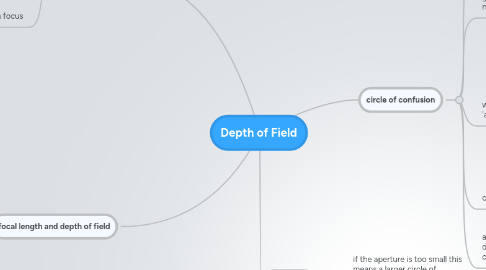
1. focal length and depth of field
1.1. telephoto lenses
1.1.1. magnify subject
1.1.2. more shallow depth of field
1.2. constant with focal length
1.2.1. examples: focal length : 10 focus distance: 0.5 depth of field: 0.482
1.3. depth of field traditional concept
1.3.1. exposure only counts for depth of field and not area around focal plane
1.3.2. with wide angle lens makes the area behind depth of field more blurred than in the front of the focal field
1.4. longer focal length means more shallow depth of field
1.4.1. background is enlarged
1.4.2. higher magnification means more shallow
1.5. calculating depth of field
1.5.1. camera type
1.5.2. viewing distance
2. depth of focus
2.1. also known as "focus spread"
2.2. unlike depth of field, instead of the distance from the subject, focuses on the light applied to the camera's sensor
2.3. object is in focus
2.3.1. all light rays from different points hit the same point on camera's sensor
2.3.2. if light rays hit different areas instead of the same point, the object is out of focus
3. circle of confusion
3.1. how blurry a point needs to be
3.2. goes outside the depth of field; no longer sharp
3.2.1. depth of field based on when circle becomes bigger than camera's pixels
3.2.2. regions that become out of focus cannot be described by depth of field, only the part of the image that is actually sharp
3.3. when is the circle of confusion 'acceptably sharp'?
3.3.1. standard 8x10 in. print
3.3.2. standard viewing distance of 1ft.
3.3.3. most use 0.01 in. standard
3.3.4. those with 20/20 vision can make out features 1/3 of the standard size or smaller
3.4. circle of confusion not actually circle
3.4.1. only seen as circle when small
3.4.2. when larger, seen as polygon; 5-8 sides
3.5. aperture and focal distance decide how big circle of confusion will be
3.5.1. larger aperture and closer focus means depth of field will be more shallow
